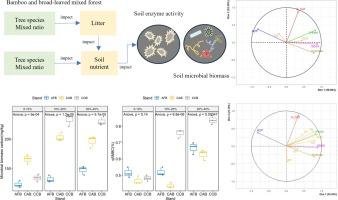树种对竹阔叶混交林小尺度空间土壤特性和微生物活动的影响
IF 5.7
1区 农林科学
Q1 GEOSCIENCES, MULTIDISCIPLINARY
引用次数: 0
摘要
土壤酶活性和微生物生物量在无数生态过程中发挥着至关重要的作用。竹阔叶混交林作为生态恢复和可持续发展的重要林业模式受到广泛关注;然而,我们对竹阔叶混交林中阔叶树种对土壤性质和微生物活动的影响仍不清楚。在此,我们取样研究了 27 个空间间隔的竹-楠木混交林(CCB)、竹-楠木(Hemsl.混交林(CAB),研究树种和混交比例对土壤养分、微生物生物量和酶活性的影响。我们发现,不同森林的土壤养分水平存在差异。CAB 森林的 C、N 和 P 平均含量明显高于 AFB 和 CCB,尤其是在混合比为 10-20% 时,SOC 浓度达到 46.50 g/kg。与 AFB 和 CCB 森林相比,CAB 森林的转化酶(平均 701.83U/g)、脲酶(8393.44U/g)和过氧化氢酶(501.73U/g)活性明显更高,在混合比为 10-20% 时,酶活性达到峰值。CAB 和 CCB 森林的土壤微生物生物量 C 和 N 明显高于 AFB 森林。CAB 森林的土壤微生物生物量 P 也最高(平均 48.68 mg/kg),且随着混合比的增加而持续上升。多因素分析表明,酶活性与森林中细根的年生长量显著相关,并与常住 C、总 N、总 P、C:N 和 C:P 呈正相关。总之,研究结果揭示了竹阔叶混交林中树种和树冠大小对土壤特性和微生物活性的重要性,同时为选择混交树种以实现竹林土壤微环境的可持续管理提供了管理指导。本文章由计算机程序翻译,如有差异,请以英文原文为准。

The influence of tree species on small scale spatial soil properties and microbial activities in a mixed bamboo and broad-leaved forest
Soil enzyme activity and microbial biomass play a critical role in myriad ecological processes. Bamboo and broad-leaved mixed forests have received widespread attention as important forestry models for ecological restoration and sustainable development; however, our understanding the influences of broad-leaved tree species in mixed bamboo forests on soil properties and microbial activity remains unclear. Here we sampled twenty-seven spatially interspersed stands of bamboo-Castanopsis chinensis Hance mixed forest (CCB), bamboo-Alniphyllum fortune (Hemsl.) Makino mixed forest (AFB), and bamboo-Choerospondias axillaris mixed forest (CAB), with different mixing ratios (0–10 %, 10–20 %, 20–40 % canopy proportions) in subtropical China, to examine the effects of tree species and mixed ratio on soil nutrients, microbial biomass, and enzyme activity. We found that the different forests exhibited variations in soil nutrient levels. CAB forests exhibit notably higher mean C, N, and P contents than AFB and CCB, particularly at a 10–20 % mixing ratio where SOC concentration reached 46.50 g/kg. CAB forests demonstrated significantly higher activities of invertase (mean 701.83U/g), urease (8393.44U/g), and catalase (501.73U/g) compared to AFB and CCB forests, with peak enzyme activities observed at a 10–20 % mixing ratio. Soil microbial biomass C and N were notably greater in CAB and CCB forests than in AFB forests. CAB forests also exhibited the highest soil microbial biomass P (mean 48.68 mg/kg), which rose consistently with an increased mixing ratio. Multiple factor analysis revealed that the enzyme activities were significantly correlated with the annual growth of fine roots in the forest and were positively correlated with resident C, total N, total P, C: N, and C: P. Overall, the results provide insights into the importance of tree species and crown size in bamboo and broadleaved tree mixed forest in soil features and the microbial activity while providing management guidance for the selection of mixed tree species for sustainable management of bamboo forest soil microenvironment.
求助全文
通过发布文献求助,成功后即可免费获取论文全文。
去求助
来源期刊

Catena
环境科学-地球科学综合
CiteScore
10.50
自引率
9.70%
发文量
816
审稿时长
54 days
期刊介绍:
Catena publishes papers describing original field and laboratory investigations and reviews on geoecology and landscape evolution with emphasis on interdisciplinary aspects of soil science, hydrology and geomorphology. It aims to disseminate new knowledge and foster better understanding of the physical environment, of evolutionary sequences that have resulted in past and current landscapes, and of the natural processes that are likely to determine the fate of our terrestrial environment.
Papers within any one of the above topics are welcome provided they are of sufficiently wide interest and relevance.
 求助内容:
求助内容: 应助结果提醒方式:
应助结果提醒方式:


